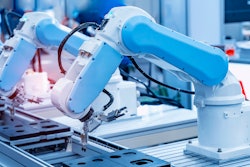TUCSON, Ariz. (AP) -- Someday perhaps in the not-too-distant future, you may have a doctor's appointment to implant a tiny electronic chip in your body to monitor a medical condition.
But you won't need another appointment to take it out.
Researchers including a top University of Arizona cardiologist have developed a new kind of biodegradable electronics robust enough for applications such as medical implants yet completely dissolvable in water or bodily fluids.
The so-called "transient electronics" technology was developed by researchers at the University of Illinois, led by engineering professor John A. Rogers, along with UA cardiologist Dr. Marvin Slepian and scientists at Tufts University and Northwestern University.
The group's findings are reported in the Sept. 28 issue of the journal Science.
The technology could have broad applications for medical implants, environmental monitors and consumer devices.
The researchers have already demonstrated several system-level devices, including a fully transient 64-pixel digital camera and an implantable appliqué designed to monitor and prevent bacterial infection at surgical incisions, which was successfully demonstrated in rats.
"There are implants that are put into the body that are only needed for a limited period of time," Slepian said. "After that, they either stay in permanently or you make them to come out readily. Using this type of technology, it allows things to resorb completely."
Slepian noted that he and Rogers last year published a paper on "stretchable" electronics that researchers integrated into standard balloon catheters used on the heart. A startup company in Boston is working to commercialize that technology.
"We thought, 'Well, how about if you just have the whole thing disappear?' " said Slepian, who is director of the UA's Interventional Cardiology program and Tissue Engineering Lab.
Dissolvable materials have been used to make simple medical devices, such as sutures and biodegradable heart stents that Slepian himself pioneered in the 1980s.
Dissolvable electronics present a whole new set of challenges.
But in transient applications, the sheets are so thin that they completely dissolve in a few days when immersed in bodily fluids, Slepian said. The researchers encapsulate the devices in silk, whose structure determines its rate of dissolution - from minutes, to days, weeks or perhaps years.
Together with soluble conductors and dielectrics, based on magnesium and magnesium oxide, the technology can produce a wide range of electronic components. The research team already has built transient transistors, diodes, wireless power coils, temperature and strain sensors, photodetectors, solar cells, radio oscillators and antennas, and even simple digital cameras.
Slepian said his main role has been to develop broader applications and to conduct biological experiments, including planned studies of the body's tolerance of transient-electronics residues.
The prototype circuits are postage-stamp size, but the technology could be adapted to smaller, nanoscale circuitry, Slepian said, noting that his lab already is working on surface-modification technologies at the 100-nanometer level.
Slepian also is looking at uses for the technology with the CardioWest Temporary Total Artificial Heart, a bridge-to-transplant device developed and marketed by Tucson-based SynCardia Systems.
Transient electronics could be used to monitor the blood pressure of new Total Artificial Heart patients, said Slepian, who co-founded SynCardia and serves as chief scientific and medical officer of the company. More than 1,000 of the bridge-to-transplant hearts have been implanted in patients.
"We really would like to be flying with instruments, if you will, for a few weeks as the patient heals," Slepian said, adding that the technology could also be adapted to automatically adjust blood pressure.
Other potential medical applications range from catheters that dissolve once they are no longer needed to temporary sensors measuring kidney or lung function.
Another use for transient electronics is environmental monitoring, such as wireless sensors that are dispersed after a chemical spill and degrade over time to eliminate any ecological impact.
The technology also holds promise to create consumer electronic systems or components that are compostable, to reduce electronic waste generated by devices such as cellphones.
Next, the researchers are further refining these and other devices for specific applications, conducting more animal tests, and working with a semiconductor foundry to explore high-volume manufacturing possibilities.
"It's a new concept, so there are lots of opportunities, many of which we probably have not even identified yet," Rogers said in prepared remarks.
Slepian said it's too soon to tell when or in what form transient electronics will hit the market.
"We hope that in the near future this will have broad commercialization potential, but the details are still being worked out," he said.






















